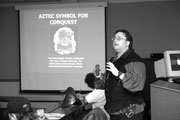Cortes lecture provides insight

Dr. John Chuchiak IV, assistant professor of history at Missouri State University, gave a lecture on Hernan Cortes Oct. 4.
With lights turned low, students were focused on Dr. John Chuchiak IV, assistant professor of history at Missouri State University, as he began the presentation, “Hernan Cortes and the Aztec Conquest: The Making of Mexico” at times emphasizing in Spanish, while in full costume.
“It’s an exciting, histrionic presentation,” said Dr. Conrad Gubera, professor of sociology. “A mixture of scholarship and theater.”
Chuchiak’s voice grabbed the attention of the audience as he began with a description of Aztec culture and their war goals — capture and sacrifice.
“It was a show of greatness to capture your enemy,” he said. “If a person of importance was captured they were sacrificed to the Gods and the skull was ritually cleaned and put on a skull rack or Tzompantli.”
The history unfolded as Cortes’s defiant nature was shown when he ignored orders from the Spanish governor of Cuba, Diego de Velasquezto, to cancel the expedition. Cortes’ men were given 20 women as a peace offering and one woman, Malinche, became their interpreter and used her knowledge to revenge the stepfather who sold her. She became Cortes’ lover and gave birth to his first son.
“I found it interesting that she would translate what she wanted to translate instead of just what was said,” said Krista Stark, senior mass communications major. “The presentation was very effective.”
The Aztecs had tribute lists and conquests and surrounding communities had to pay for protection.
“They were an Indian mafia,” Chuchiak said. “At the Aztec marketplace tributes from towns were put into a great fair and the goods were bought, sold, and traded.”
This aided Cortes in acquiring natives to help him overthrow the Aztecs.
News of the killing of Montezuma, the Aztec leader, spread and the Spaniards tried to flee unnoticed, but were caught and more than 600 conquistadors were killed.
“Many were weighed down by the gold they were carrying,” Chuchiak said.
That night is known as noche triste or “the night of tears.”
Aztecs began to die of a mysterious illness that had symptoms of “racking coughs and painful burning sores.” Smallpox spread, killing many and weakening the Aztec nation.
Cortes and his allies began in the south of the island and fought their way through the city house by house. Though better armed, the Spanish suffered losses as they fought around 300,000 Aztecs for 80 days.
When an omen confirmed that defeat was inevitable, the Aztecs surrendered and the Spaniards and their native allies looted the “Indian Mafia.”
Chuchiak’s research specialty is in colonial Latin American.
“It’s [history] an obsession I’ve had since I was five,” Chuchiak said.
For more information on upcoming Mexican semester events, please contact the Institute of International Studies at 659-4442.
Your donation will support the student journalists of Missouri Southern State University. Your contribution will allow us to purchase equipment and cover our annual website hosting costs.















